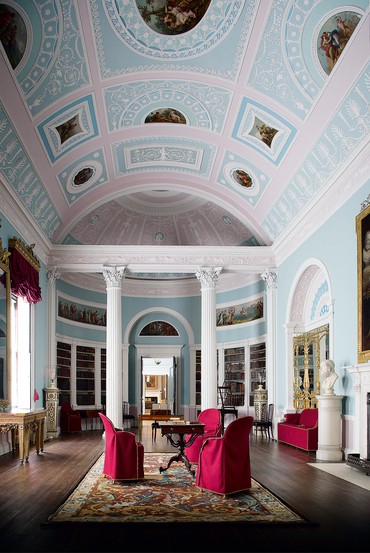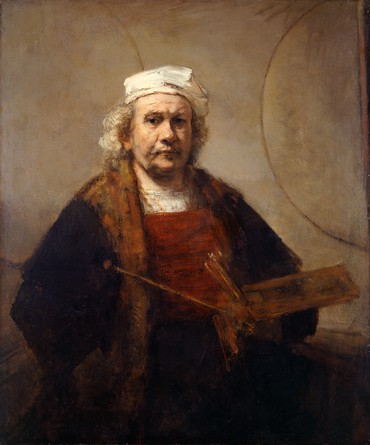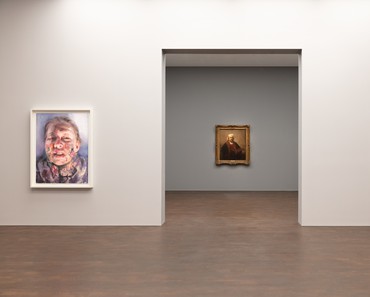
Anna Eavis is curatorial director of English Heritage, with responsibility for the presentation of over four hundred historic sites and their collections. Eavis is a trustee of the Stained Glass Museum, Ely, and of the Leeds Castle Foundation, and is a member of the fabric advisory committees at Salisbury Cathedral and Canterbury Cathedral.
Kenwood House stands on the edge of Hampstead Heath, a rambling public park five miles north of central London. A magnificent villa largely created by the great Scottish architect Robert Adam, and surrounded by a landscape designed by Humphrey Repton, it is an extraordinary survival of an eighteenth-century gentleman’s estate. Cared for by English Heritage, a charity responsible for over four hundred historic sites, it is home to a remarkable collection of paintings, including Rembrandt’s Self-Portrait with Two Circles (1665).
Adam began remodeling Kenwood in 1767 for William Murray, the lord chief justice and first earl of Mansfield, who had purchased the house in 1754 as a weekend escape from central London. Murray instructed Adam to improve its external appearance, modernize the interior, and accommodate his great collection of books. The result—which took fifteen years to deliver—was stunning, much admired by contemporaries and still loved by thousands of Londoners today. Adam paid tribute to his excellent client, who “gave full scope to my ideas.” In return he created for Murray an exceptional house with some of England’s finest eighteenth-century interiors, several of which English Heritage has recently restored.
Most impressive is Kenwood’s library, inspired by classical models, where Murray kept his books and entertained. He and his wife, Lady Elizabeth, were popular hosts; he had “the happy and engaging art of putting the company present in good humour with themselves. . . . they naturally liked him the more for his seeming to like them so well.” The library, restored to Adam’s original color scheme, remains a highlight of a visit to Kenwood—now, as in the eighteenth century, the climax of the guest route through the house. The eye is immediately drawn to the vast gilded pier glasses, the white apse columns, the ornamental motifs, and the delicate blues and pinks of the ceiling, in which are set nineteen oil paintings by Antonio Zucchi. Their subjects, which include several references to justice, must have been devised collaboratively by the artist, the architect, and their lawyer client. They include symbolic figures of Theology, Jurisprudence, Mathematics, and Philosophy, and vignettes of Justice embracing Peace, Commerce, Navigation, and Agriculture. The central image is of the demigod Hercules resisting temptation, a subject surely alluding to Murray’s wisdom of judgment.
During the nineteenth century, successive earls of Mansfield became less and less interested in Kenwood, spending more time at Scone Palace, their Scottish estate. The sixth earl sold off the house’s contents in 1922, then, in 1925, the house itself and its surrounding parkland. Miraculously, a savior was at hand: Kenwood was bought by Edward Cecil Guinness, first earl of Iveagh, a wealthy Irishman who had transformed his family’s brewing business into a global enterprise and had long been assimilated into the highest stratum of London society. Guinness had become fond of Kenwood during World War I, when he lived nearby, in the village of Hampstead. Not only was he a supremely effective businessman, he also possessed a superlative art collection, and, as he was approaching the end of his life, he was keen to find somewhere to house some of his treasures in perpetuity and for the public good. Guinness selected sixty-three paintings—many by the great British artists of the late-eighteenth and nineteenth centuries—to hang at Kenwood, but died in 1927, before his builders had finished their repairs to the house. At his death he was the second-richest man in Britain, and his estate owed considerable death duties to the government (such a large sum, in fact, as to lead to a general income-tax cut). These levies were somewhat modified by a sizeable tax deduction: the bequest of Kenwood and those sixty-three paintings to the British nation. The house and paintings—hung by Sir Charles Holmes, director of the National Gallery—opened to the public on July 18, 1928.
The Iveagh Bequest is undoubtedly the most important collection of old master paintings to be given to Great Britain in the twentieth century. No other gallery in London has on permanent view so many paintings by Thomas Gainsborough, Joshua Reynolds, and George Romney. These appear alongside works by Dutch and Flemish painters of the seventeenth century such as Rembrandt and Van Dyck, to whom their British heirs looked for inspiration, and by Guardi, Hals, and Vermeer, who were just being rediscovered in the 1880s, when Lord Iveagh was putting together his collection. The rooms at Kenwood are filled with full-length portraits of the most glamorous women in Georgian England, captivating paintings of children, and a rich collection of Dutch and Flemish landscapes and seascapes. The collection also includes The Guitar Player, one of only thirty-six works in the world to be attributed to Vermeer.
Guinness formed his collection at speed in his early forties, purchasing over two hundred pictures between 1887 and 1891, in order to furnish his vast new London residence, 5 Grosvenor Place, at the smart end of Piccadilly. His appetite for acquisition was so great that his dealer, Agnew’s, had sometimes to buy from rival operations. Soon, other clients were complaining that someone was getting first pick of their stock. Guinness liked to buy paintings from hard-up aristocratic families, not only because of the prestige associated with their provenance but because of the greater likelihood of their authenticity. He also preferred pictures that had been recently exhibited—and exposed to the scrutiny of critics—for the same reason. Guinness made many of his purchases in secret, insisting that the seller and family should be absent when he came to view their pictures. He lent his paintings to exhibitions anonymously and rarely allowed them to be reproduced. He hung them in the rooms in which he lived, and never published the catalogue that William Agnew produced for him in 1891. Guinness’s influence as a collector was significant, his intense buying campaign consolidating market taste and prices. His most expensive purchase was the Rembrandt self-portrait, bought with another painting, then also thought to be by Rembrandt, for £27,500. This was money well spent, even though the partner painting turned out to be misattributed.
Rembrandt created at least eighty self-portraits over a period of more than forty years. Produced in different forms—paintings, etchings, drawings—for many different reasons, they vary in scale and type, including small studies done in the mirror, historical cameos, and character heads in fancy costume. In the 1630s and ’40s he depicted himself in poses borrowed from Raphael, Rubens, and Titian, wearing elaborate costumes or fashionable clothes; in the 1650s he more often painted himself as a working artist in studio attire. The Kenwood painting—made in 1665, toward the end of his life—is unlike any of its predecessors but may represent a culmination of them all.
This is the largest of Rembrandt’s self-portraits but for the 1658 painting now in the Frick Collection, New York. The artist appears at work in his studio. He is shown holding the tools of his trade: a palette, some brushes, and the maulstick used to rest his painting hand. He wears a fur-trimmed robe over a red smock, with a gilt chain tucked into his shirt front. On his head is a simple white linen cap. The canvas on which he is working is barely visible, shown as a tilted sliver to the upper-right edge of the painting. Behind him, sketched on a strangely luminous wall, are sections of the outlines of two circles.
The figure of the artist, pyramidal in form and monumental in scale, dominates the composition. It is rendered with the full range and flourish of Rembrandt’s mature technical virtuosity. The face is the most highly finished area, every tonal variation and sagging imperfection of the painter’s aging flesh being fully realized. The dark, deep-set eyes—one in almost complete shadow—are by contrast painted in with delicate glazes. Their steady gaze is frankly appraising, almost unnerving. Highlights to the nose and hair are captured in impasto. The whiskery moustache and an eyebrow were scored into the wet paint with the wooden tip of the handle of the artist’s brush. The dense brushwork of the face contrasts with the simplicity of the linen cap, which is formed of a few slabs of tinted white paint, made luminous with two or three sparingly applied highlights. For the fabric and golden fur of the smock and tabard, Rembrandt’s technique is different again: the subtle variations in color and texture are built up with soft scumbling. The brushes and maulstick are rapidly drawn, and the hand holding them is evoked only by a bundle of sketch lines. The other hand has disappeared, read by the viewer as being tucked inside a pocket or on the artist’s hip.
These effects, which a post-nineteenth-century eye might view as impressionistic, have also been seen as evidence of incompletion. When Joshua Reynolds saw the painting, in Brussels in 1781, he described it as “very unfinished. . . . his hand, if it may be so called . . . is so slightly touched, that it can scarce be made out to be a hand.” Reynolds was sufficiently impressed, however, to paint his own self-portrait emerging from the shadow in tribute, and this painting Guinness also acquired; today it hangs close to the Rembrandt painting at Kenwood. Iveagh himself had grouped the two paintings at Grosvenor Place, presumably appreciating the juxtaposition.
The circles on the wall behind the figure have also been cited as evidence of an unfinished composition, and scholars have puzzled over their meaning. One theory is that they represent the underdrawing for a representation of a map of the world; another is that they symbolize Rembrandt’s supreme artistry, referring to the famous story of Giotto’s freehand drawing of a perfect circle. The figure of Rembrandt himself has been variously interpreted as an image of a man weakened by misfortune and old age and as an emblem of fortitude, experience, and wisdom. Such assessments are inevitably subjective; what seems unassailable is the monumentality, power, and sheer technical brilliance of the painting. It is unforgettable.
Self-Portrait with Two Circles hangs today in the dining room at Kenwood. Soon after it went on display, in 1928, its custodians noticed a “dangerously active” bloom on the painting, patches on the varnish that appeared and disappeared as the relative humidity changed. The press reported a “varnish disease attacking the paint,” putting Kenwood at the center of early debates about approaches to painting conservation. The painting was moved to a drier environment and unglazed. In the 1930s, an enthusiastic staff member cut holes in the canvas backing to let the painting “breathe.” Nowadays it is glazed and backed and its condition remains stable.
In 1986 Kenwood passed into the care of English Heritage, then a government agency. When, in 2015, English Heritage became an independent charity, it renewed its commitment to ensure that Lord Iveagh’s generous bequest, which has been enjoyed by the public for over ninety years, continues to be a source of delight, study, and reflection. In this year, the three hundred and fiftieth anniversary of the death of Rembrandt, Gagosian joined forces with English Heritage to stage an exhibition at its Mayfair gallery. Rembrandt’s painting is the centerpiece of Visions of the Self: Rembrandt and Now, an exhibition of self-portraits by artists including Francis Bacon, Jean-Michel Basquiat, Lucian Freud, Jenny Saville, and Pablo Picasso.
Photos, unless otherwise noted: © Historic England Archive; Kenwood House is open to visitors almost every day of the year, and is completely free to enter.
















